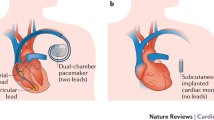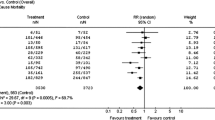Abstract
Atrial fibrillation is a very frequent and potentially dangerous cardiac arrhythmia, increasing in prevalence with advancing years (from < 0.3% between 25 and 35 years of age to > 5% between 62 and 90 years of age) [1]. The arrhythmia is a source of substantial morbidity and mortality and is associated with increased medical care costs. The risk of systemic embolism and stroke is approximately 3- to 5-fold enhanced in patients with atrial fibrillation and full anticoagulation is frequently recommended in these patients [2]. The loss of atrial contraction and the irregularity of RR intervals reduce cardiac performance and may precipitate heart failure in patients with organic heart disease. It is also possible that a tachycardia-induced cardiomyopathy develops as consequence of a persistently high ventricular rate during atrial fibrillation [3]. Quality of life is frequently compromised by the occurrence of atrial fibrillation and patients often complain of disabling symptoms such as palpitations, fatigue, dyspnea and angina [4]. Finally, the risk of dying is 1.5- to 1.9-fold increased in patients with atrial fibrillation, even after adjustment for other variables [5]. Atrial fibrillation is also the most common cardiac rhythm disorder associated with hospitalization, being responsible for 0.5% of all hospital admissions and for one-third of all arrhythmia principal diagnoses [6]. It has been estimated that hospital costs are 12% to 24% higher in patients with atrial fibrillation compared with those without atrial fibrillation [7].
Access this chapter
Tax calculation will be finalised at checkout
Purchases are for personal use only
Preview
Unable to display preview. Download preview PDF.
Similar content being viewed by others
References
Kannel WB, Wolf PA (1992) Epidemiology of atrial fibrillation. In: Falk RH, Podrid PJ (eds) Atrial fibrillation. Mechanisms and management. Raven, New York, pp 81–93
Atrial fibrillation Investigators (1994) Risk factors for stroke and efficacy of antithrombotic therapy in atrial fibrillation: analysis of pooled data from five randomized controlled trials. Arch Intern Med 154:1449–1457
Shinbane JS, Wood MA, Jensen DN et al (1997) Tachycardia-induced cardiomyopathy: a review of animal models and clinical studies. J Am Coll Cardiol 29:709–715
Jung W, Herwig S, Newman D et al (1999) Impact of atrial fibrlation on quality of life: a prospective, multicenter study. Circulation 33[Suppl A]:104A (abstr)
Benjamin EJ, Wolf PA, D’Agostino RB et al (1998) Impact of atrial fibrillation on the risk of death. The Framingham heart study. Circulation 98:946–952
Bialy D, Lehmann MH, Schumacher DN, et al (1992) Hospitalization for arrhythmias in the United States: importance of atrial fibrillation (abstract). J Am Coll Cardiol 19:41A
Wolf PA, Mitchell JB, Baker CS et al (1995) Mortality and hospital costs associated with atrial fibrillation. Circulation 92 [Suppl I]:I–140 (abstr)
Raviele A, Gasparini G, Bonso A et al (1999) Current role of implantable atrial defibrillator in the treatment of paroxysmal atrial fibrillation. G Ital Aritmol Cardiostim 1 (in press)
Wijffels MCEF, Kirchof CJHJ, Dorland R, Allessie MA (1995) Atrial fibrillation begets atrial fibrillation. A study in awake chronically instrumented goats. Circulation 92:1954–1968
Wellens HJJ, Lau CP, Luderitz B et al (1998) Atrioverter: an implantable device for the treatment of atrial fibrillation. Circulation 98:1651–1656
Lerman B, Stein K, Markowitz S (1998) Worldwide clinical experience with the model 7250 Jewel AF dual chamber arrhythmia management device. PACE 21:872 (abstr)
Wharton M (1998) Treatment of spontaneous atrial tachyarrhythmias with the Medtronic 7250 Jewel AF: worldwide clinical experience. Circulation 98[Suppl]:I–190 (abstr)
Murgatroyd FD, Slade AKB, Sopher SM et al (1995) Efficacy and tolerability of transve-nous low energy cardioversion of paroxysmal atrial fibrillation in humans. J Am Coll Cardiol 25:1347–1353
Santini M, Pandozi C (1997) La cardioversione endocavitaria a bassa energia nella fibrillazione atriale: efficacia, sicurezza, tollerabilità, indicazioni e prospettive future. G Ital Cardiol 27:191–196
Tomassoni G, Newby KH, Kearney MM et al (1996) Testing different waveforms and capacitances: effect on atrial defibrillation threshold and pain perception. J Am Coll Cardiol 28:695–699
Bump T, Yurkonis C, Brown J et al (1989) Automatic implantable drug delivery for conversion of atrial fibrillation. In: Update in drug delivery systems. Futura Mt Kisco NY, pp 303–309
Arzbaecher R, Gemperline J, Haklin M et al (1998) Rapid drug infusion for termination of atrial fibrillation in an experimental model. PACE 21:288–291
Tse H, Lau C, Sra J et al (1999) Atrial fibrillation detection and R-wave synchronization by Metrix implantable atrial defibrillator. Implications for long-term efficacy and safety. Circulation 99:1446–1451
Raviele A, Brignole M, Menozzi C et al (1998) Development of an implantable drug delivery system for the treatment of vasovagal syncope: a dream or a real prospect? In: Raviele A (ed) Cardiac arrhythmias 1997. Springer, Milano, pp 422–427
Vereckei A, Arnett CJ, Warman E et al (1999) Comparison of the effects of right atrial and intravenous procainamide delivery on drug levels, electrophysiological parameters and termination of atrial fibrillation in dogs. PACE 22:18 (abstr)
Author information
Authors and Affiliations
Editor information
Editors and Affiliations
Rights and permissions
Copyright information
© 2000 Springer-Verlag Italia
About this paper
Cite this paper
Bonso, A., Gasparini, G., Themistoclakis, S., Giada, F., Raviele, A. (2000). Implantable Atrial Defibrillator: Why not a Patient-Activated Drug Delivery System?. In: Raviele, A. (eds) Cardiac Arrhythmias 1999. Springer, Milano. https://doi.org/10.1007/978-88-470-2139-6_17
Download citation
DOI: https://doi.org/10.1007/978-88-470-2139-6_17
Publisher Name: Springer, Milano
Print ISBN: 978-88-470-2178-5
Online ISBN: 978-88-470-2139-6
eBook Packages: Springer Book Archive




